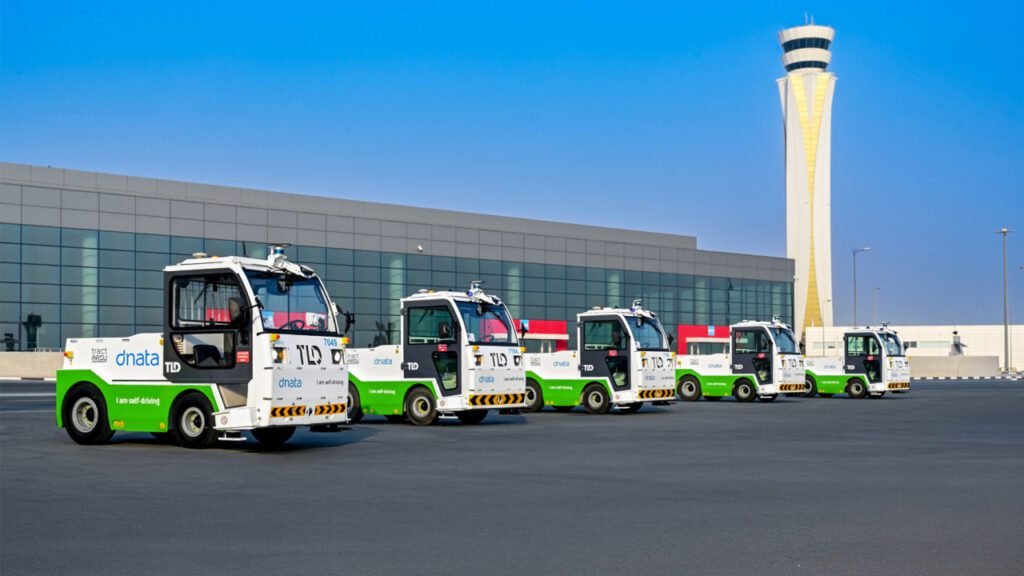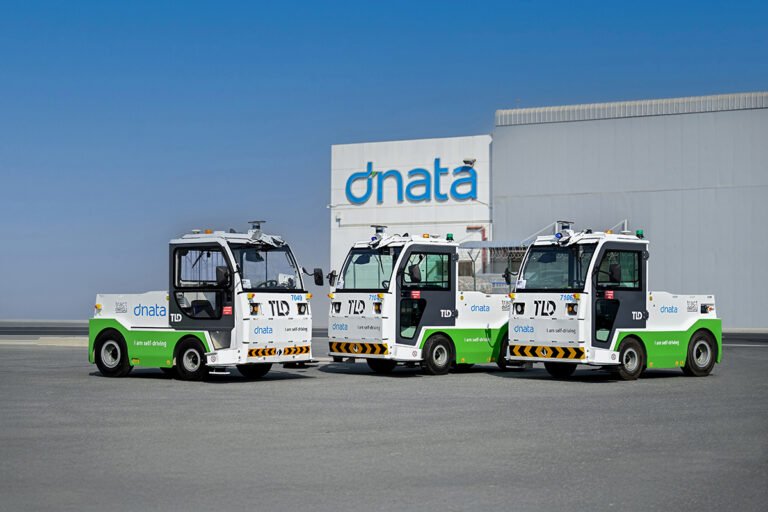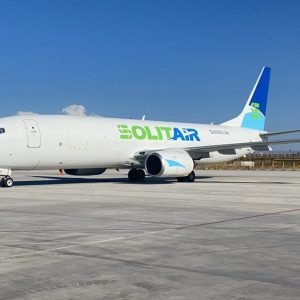When it comes to aviation innovation, Dubai is always ahead of the curve. Now, dnata, one of the world’s leading air services providers, has taken a major step forward by introducing driverless electric tractors at Dubai World Central airport. This move not only represents a technological breakthrough but also aligns with the UAE’s strong focus on sustainability and smart city initiatives.
In this article, we will explore why these driverless electric tractors at Dubai airport are such a game-changer. We’ll cover what they are, how they work, the benefits they offer, and what this means for the future of air travel and ground operations.
Why Dubai? The City of Innovation
Dubai is known for pushing boundaries in every sector, from the world’s tallest building to driverless metro trains. It comes as no surprise that Dubai World Central (DWC), also known as Al Maktoum International Airport, is the first airport in the region to deploy driverless electric tractors.

DWC was designed to handle more than 160 million passengers and 12 million tonnes of cargo annually in the future. This ambitious vision demands cutting-edge technology and seamless logistics. dnata’s move to automate and electrify ground handling operations is a major step toward making this vision a reality.
What Are Driverless Electric Tractors?
Driverless electric tractors are autonomous vehicles used to tow baggage carts, cargo dollies, and other ground support equipment. They operate without a human driver and run entirely on electric power.

Key features include:
- Autonomous navigation using advanced sensors and AI
- Zero emissions since they are fully electric
- Real-time obstacle detection and avoidance, making them safer
- Integration with airport traffic systems, allowing smooth and efficient movements
By deploying driverless electric tractors at Dubai airport, dnata aims to improve operational efficiency, reduce emissions, and increase safety.
How Do Driverless Electric Tractors Work?
These tractors use a combination of GPS, lidar (light detection and ranging), cameras, and onboard AI systems to understand their environment. Here’s how they operate:
- Pre-defined routes: The tractors are programmed to follow specific routes on the airport apron.
- Obstacle detection: Lidar and cameras detect other vehicles, aircraft, and personnel, allowing the tractor to slow down or stop as needed.
- Remote monitoring: Operators can oversee the fleet in real time from a central control center.
- Energy management: The tractors automatically head to charging stations when their batteries run low.
This combination of smart navigation and electric power makes these tractors perfect for modern airport operations.
Benefits of Driverless Electric Tractors at Dubai Airport
Reduced Carbon Emissions
One of the most significant advantages is environmental sustainability. dnata has long been committed to reducing its carbon footprint. By using electric tractors instead of diesel-powered ones, the company cuts emissions drastically. This supports Dubai’s larger goals under its Clean Energy Strategy 2050.
Improved Operational Efficiency
Automation means more predictable and reliable operations. The tractors can run continuously without breaks, thus increasing turnaround times for flights. Quicker ground handling directly benefits airlines and passengers by reducing delays.
Enhanced Safety
Human error is one of the main causes of ground accidents at airports. Driverless tractors reduce the likelihood of such incidents, as they follow strict algorithms and respond instantly to their surroundings.
Lower Operational Costs
While the initial investment in autonomous vehicles is high, operational costs decrease over time due to savings on fuel, maintenance, and labor.

dnata’s Vision for Smart Ground Handling
dnata has been a pioneer in aviation services since 1959. Today, it serves over 300 airline customers in more than 30 countries. The deployment of driverless electric tractors at Dubai airport is part of a larger strategy to build a fully integrated smart ground handling system.
This initiative includes:
- Digital tracking of baggage and cargo
- Automated loading and unloading
- Integration with airline IT systems for real-time updates
These steps align with dnata’s long-term vision of becoming the most efficient and environmentally friendly ground services provider in the world.
Sustainability at the Heart of Innovation
Sustainability is not just a buzzword for dnata or Dubai. The UAE has set ambitious targets to become carbon-neutral by 2050. Transport and aviation play a significant role in achieving this.
By introducing driverless electric tractors at Dubai airport, dnata contributes directly to:
- Reducing local air pollution
- Cutting noise levels on the apron
- Promoting renewable energy use by charging vehicles from green sources wherever possible
This move sets an example for airports around the globe to adopt similar practices and help tackle climate change.
Global Context: Dubai Leading the Way
Many airports worldwide are experimenting with electric and autonomous ground vehicles. Amsterdam’s Schiphol, London Heathrow, and Los Angeles International Airport have pilot programs in place. However, dnata’s deployment at DWC is one of the most comprehensive and ambitious implementations to date.
Dubai’s success with driverless metro trains, autonomous police patrols, and now driverless electric tractors at Dubai airport cements its position as a global leader in smart transport solutions.
Challenges and Future Opportunities
As with any new technology, challenges exist:
- High initial costs: The price of electric and autonomous tractors is still relatively high.
- Infrastructure needs: Airports need to install charging stations and upgrade apron layouts.
- Regulatory approvals: Strict aviation safety standards require thorough testing and certifications.
Despite these challenges, the potential for future expansion is immense. dnata could further integrate AI to predict maintenance needs, optimize energy use, and coordinate tractors with other autonomous vehicles.
In the future, we may see fully automated airports where cargo, baggage, catering, and even aircraft pushbacks are all handled by electric autonomous fleets. Dubai is well-positioned to make this a reality sooner than most.

A Look Ahead: The Smart Airport Vision
The deployment of driverless electric tractors at Dubai airport is more than just a technological upgrade. It symbolizes the future of air travel — smarter, greener, and more efficient.
Imagine arriving at an airport where:
- Your baggage is automatically tagged and moved by an electric robot
- Ground vehicles operate seamlessly without drivers, minimizing congestion and emissions
- All logistics are connected digitally, providing real-time updates to airlines and passengers
This is not a distant dream but a glimpse of what airports like Dubai World Central are rapidly moving toward.
Passenger Experience: Indirect Yet Significant Benefits
Although most passengers will not directly interact with these tractors, they will feel the benefits through:
- Faster baggage delivery
- More punctual flight departures and arrivals
- Cleaner air and quieter apron environments
For airlines, the benefits translate into improved efficiency and cost savings, which can be reinvested into better services for travelers.
Conclusion: A Milestone for dnata and Dubai
The introduction of driverless electric tractors at Dubai airport is a bold and forward-thinking move. It highlights dnata’s commitment to sustainability, efficiency, and innovation. At the same time, it strengthens Dubai’s reputation as a global aviation hub leading the way toward a smart and sustainable future.
As more airports and ground handling companies around the world observe Dubai’s success, we can expect a ripple effect of similar innovations in the coming years. For now, dnata has set a new standard, and the rest of the world is watching.
Do follow UAE Stories on Instagram
Read More: Light Rain Brings Brief Respite to Sharjah and Ras Al Khaimah














